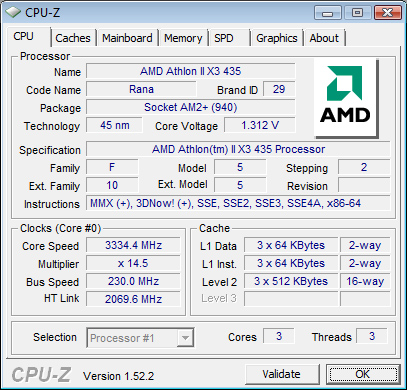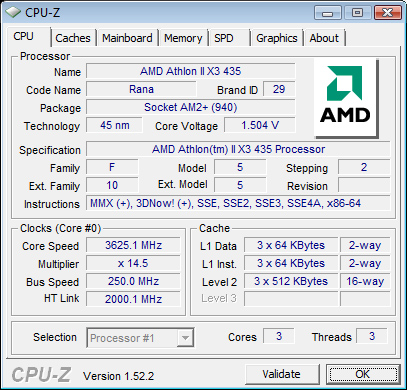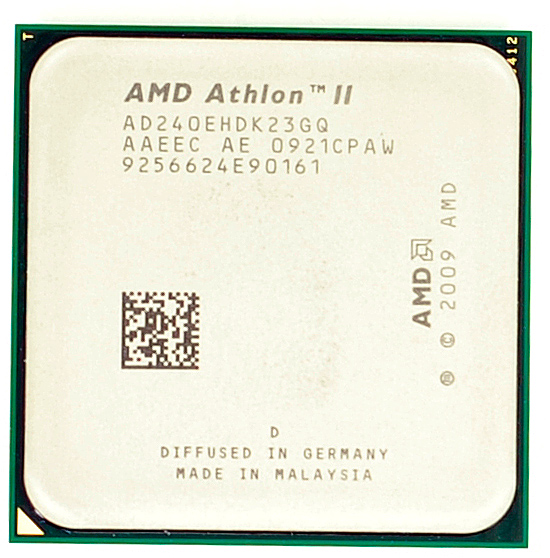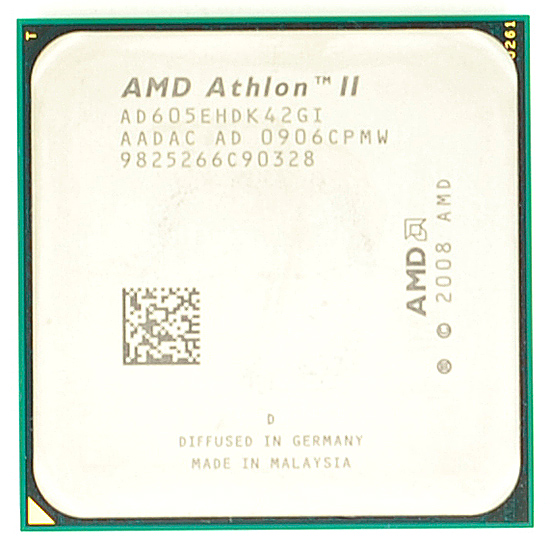AMD's Athlon II X3 435 & New Energy Efficient CPUs: Killing Intel Below $90
by Anand Lal Shimpi on October 20, 2009 12:00 AM EST- Posted in
- CPUs
A month ago AMD introduced the world’s first quad-core processor to debut at $99. Last week, AMD announced its third quarter earnings for 2009. While the company as a whole lost money, the Product Company (CPU and GPU design) turned a small profit. I don’t want to say that the worst is behind AMD, but things are definitely looking up.
| Income | Q3 2009 | Q2 2009 | Q1 2009 |
| AMD | -$128 Million | -$330 Million | -$416 Million |
| AMD Product Company | +$2 Million | -$244 Million | -$308 Million |
And for the consumer, AMD is providing a ton of value these days. You're getting more transistors per dollar than Intel will give you, and it's not just bloat, these things are fast:
| Processor | Cores | Manufacturing Process | L1 Cache | L2 Cache | L3 Cache | Die Size | Transistor Count |
| AMD Phenom II X4 | 4 | 45nm | 128KB per core | 512KB per core | 6MB | 258 mm2 | 758M |
| AMD Athlon II X4/X3 | 4 | 45nm | 128KB per core | 512KB per core | 0MB | 169 mm2 | 300M |
| AMD Athlon II X2 | 2 | 45nm | 128KB per core | 1MB per core | 0MB | 117 mm2 | 234M |
| Intel Core 2 Quad Q8xxx | 4 | 45nm | 64KB per core | 4MB | 0MB | 164 mm2 | 456M |
| Intel Pentium E6xxx | 2 | 45nm | 64KB per core | 2MB | 0MB | 82 mm2 | 228M |
The value train continues with todays introduction of the first triple core Athlon II processors: the Athlon II X3 435 and 425. Clocked at 2.9GHz and 2.7GHz respectively, these processors are simply Athlon II X4s with one core disabled.

They’re also quite affordable. The 435 will set you back $87 while the 425 costs $76. This puts them on par with Intel’s Pentium E6000 series dual core processors, but cheaper than the Core 2 Duo E7500. This has been AMD’s high end dual core strategy for the Phenom’s life: sell three cores for the price of two. And in the past, it has worked.
| Processor | Clock Speed | L2 Cache | L3 Cache | TDP | Price |
| AMD Phenom II X4 965 BE | 3.4GHz | 2MB | 6MB | 140W | $245 |
| AMD Phenom II X4 955 BE | 3.2GHz | 2MB | 6MB | 125W | $245 |
| AMD Phenom II X4 945 | 3.0GHz | 2MB | 6MB | 125W | $225 |
| AMD Phenom II X3 720 BE | 2.8GHz | 1.5MB | 6MB | 95W | $145 |
| AMD Phenom II X2 550 BE | 3.1GHz | 1MB | 6MB | 80W | $105 |
| AMD Athlon II X4 630 | 2.8GHz | 2MB | 0MB | 95W | $122 |
| AMD Athlon II X4 620 | 2.6GHz | 2MB | 0MB | 95W | $99 |
| AMD Athlon II X3 435 | 2.9GHz | 1.5MB | 0MB | 95W | $87 |
| AMD Athlon II X3 425 | 2.7GHz | 1.5MB | 0MB | 95W | $76 |
| AMD Athlon II X2 250 | 3.0GHz | 2MB | 0MB | 65W | $87 |
| AMD Athlon II X2 245 | 2.9GHz | 2MB | 0MB | 65W | $66 |
| AMD Athlon II X2 240 | 2.8GHz | 2MB | 0MB | 65W | $60 |
The X3s AMD is announcing today are clocked high enough that you still have good performance in single threaded applications, and in those that can take advantage of three cores you’re almost guaranteed to have better performance than the Intel alternative.
The real question you have to ask is whether it makes more sense to spend a little more than get a quad-core processor or not.
The Athlon II X3s are 45nm 95W TDP parts and work in both Socket-AM2+ and Socket-AM3 motherboards. As I mentioned before, these are architecturally identical to the X4s just with one core disabled. That means you get a 512KB L2 per core but no L3 cache.
I’ll spoil the surprise for you here: they’re faster than the equivalently priced Intel CPUs in most cases, but that’s not too surprising.
The Athlon II X3 435 is a bit more overclockable than the X4 620. Without any additional voltage we got 3.25GHz on our 620 sample, but our 435 yielded 3.33GHz:

With an extra ~15% voltage we could get 3.63GHz:

AMD is also introducing a slew of energy efficient Athlon IIs as well. They’re all in the table below:
| Processor | Clock Speed | L2 Cache | TDP | Price | Premium |
| AMD Athlon II X4 605e | 2.3GHz | 2MB | 45W | $143 | +$44 |
| AMD Athlon II X4 600e | 2.2GHz | 2MB | 45W | $133 | +$34 |
| AMD Athlon II X3 405e | 2.3GHz | 1.5MB | 45W | $102 | +$26 |
| AMD Athlon II X3 400e | 2.2GHz | 1.5MB | 45W | $97 | +$21 |
| AMD Athlon II X2 240e | 2.8GHz | 2MB | 45W | $77 | +$17 |
| AMD Athlon II X2 235e | 2.7GHz | 2MB | 45W | $69 | +$9 |
These energy efficient processors are binned for lower voltages and thus have a 45W TDP. Unfortunately you do sacrifice clock speed in some cases as a result. There's also a hefty price premium, at the high end you lose clock speed and pay 44% more for a 45W TDP.


The Test
| Motherboard: | Intel DX58SO (Intel X58) Intel DX48BT2 (Intel X48) Gigabyte GA-MA790FX-UD5P (AMD 790FX) |
| Chipset: | Intel X48 Intel X58 AMD 790FX |
| Chipset Drivers: | Intel 9.1.1.1015 (Intel) AMD Catalyst 8.12 |
| Hard Disk: | Intel X25-M SSD (80GB) |
| Memory: | Qimonda DDR3-1066 4 x 1GB (7-7-7-20) Corsair DDR3-1333 4 x 1GB (7-7-7-20) Patriot Viper DDR3-1333 2 x 2GB (7-7-7-20) |
| Video Card: | eVGA GeForce GTX 280 |
| Video Drivers: | NVIDIA ForceWare 180.43 (Vista64) NVIDIA ForceWare 178.24 (Vista32) |
| Desktop Resolution: | 1920 x 1200 |
| OS: | Windows Vista Ultimate 32-bit (for SYSMark) Windows Vista Ultimate 64-bit |










177 Comments
View All Comments
- Tuesday, October 20, 2009 - link
YO Maddoctor is ANAND!!maddoctor - Tuesday, October 20, 2009 - link
No, I'm not Anand. Anand is Intel fanboy like me, because he know only Intel who can designed an approriate processor with powerful performance.formulav8 - Tuesday, October 20, 2009 - link
Enough already. Your an absolute pestSangueffusor - Tuesday, October 20, 2009 - link
Your trolling is retardedly hilarious. Please, comment as much as you can before you get banned. I like laughing at your posts.tech4tac - Tuesday, October 20, 2009 - link
If AMD can put out inexpensive Athlon II X4 600e series desktop parts and at 45 TDP, why can't they do the same for their mobile segment:Compared to Intel's mobile processor lineup, AMD's is rather embarrassing (AMD is just not in the game). If Intel can sell the I7-820QM @ 1.73GHz and I7-720QM @ 1.60GHz (45W TDP parts @ $546.00 and $364ea in 1K quantities) for the performance notebook market, then why isn't AMD using the Athlon II X4 600e series to form the basis for a Turion II X4 product. It'd probably be 1/2 the price but with competitive performance. They could probably even drop down the clockspeed a tad to get it in the 35W TDP range (i.e. same as Mobile C2D performance parts). Then, the only thing left to work on would be idle power consumption.
Even if there is no hypothetical Turion II X4, the 600e parts could do well in desktop replacement notebooks as-is. Besides supply issues, I can't imagine any other excuse... Just my 2 cents.
fineliner - Wednesday, October 21, 2009 - link
I realize that everytime when one of us mentions something good about AMD and bad about Intel the famous doctor will respond. Let's see if I got his attention now.Back to the topic, I think this is a very interesting point raised - AMD Quad parts in mobile. Athlon II X4 605e clocks at 2.3GHz, rated at 45W TDP. So following the logic, if AMD lowers the clocks to 1.6/1.8G, they could knock down the power to, maybe 25-35W TDP. Those are very nice product offerings to notebooks.
No idea why AMD does not release such parts. Engineering problem maybe? delays?... given their track record.
I would like to see AMD bringing affordable Quad core CPUs to notebook platforms, just like what they did to bring more affordable quad parts (Athlon II X4) to desktop. At the end of the day, some of us perfers AMD or Intel, but competition is the key! At least, it will offer certain degree of motivation to Intel to keep their mobile quad prices low (or lower).
Agreed that "Competition is the foundation of getting the best bang for the buck." Competition also keeps innovation going. So credits to both AMD and Intel to bring us ever faster and cheaper processors. If only Intel's left, I don't think I would see that happening.
phaxmohdem - Tuesday, October 20, 2009 - link
I don't see the performance being very competitive unless AMD can incorporate some clone of the Turbo Boost tech into their chips. However, I agree a cheaper quad core mobile alternative would benefit us all.maddoctor - Tuesday, October 20, 2009 - link
WTF, They could not design it properly. Only Intel smarter engineers can do that with the best semiconductor manufacturing in the world. Turbo Boost in Intel is the best competitive solutions to suppress the power consumption like Mooly Eden have said.maddoctor - Tuesday, October 20, 2009 - link
Yes, because AMD is not competitive both the cost and its products performance. Many people did not know about AMD because people believe Intel is the PC. With sucks marketing, it is not surpriced AMD will face bankruptcy and soon Anandtech will only review Intel products.GeorgeH - Tuesday, October 20, 2009 - link
I understand that you want to use your standard benchmarking setup, but measuring the power consumption of these chips with a GTX280 isn't all that helpful when you consider that the vast majority of these chips are going to be paired with an IGP.It'd be nice if you could pick just one (say one of the XXXe chips) and throw it in a 780G or 785G motherboard and then measure its power consumption. From there we could extrapolate how much power the GTX280 is using to see how “Energy Efficient" these chips are in more real world setups. Saving 10-20W in the 150-200W range isn’t nearly as big of a deal as it is in the 50-100W range.